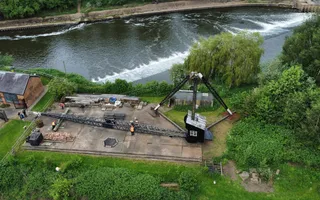Built in the 1890s by Butter Brothers in Glasgow, the crane spent much of its early life at Cardiff Docks, before moving to Diglis Island in the 1950s. There, it served a vital role lifting heavy loads, including lock gates and timber beams on and off boats on the River Severn. Sadly, in the early 2000s, after more than 100 years in service, the crane fell into disuse and disrepair. Efforts to restore it began soon after, but work stalled when the true extent of the works that were needed became apparent.
Restoring living history
Towering above the River Severn, Diglis Island's historic crane is one the last of its kind in the country. In May, we completed the latest stage of its restoration, a labour of love going back 20 years.


Joe Underhill, our national mechanical and electrical delivery manager, was part of the original team that worked on the crane. “In 2003, we turned it around and parked the crane with the jib pointing into the trees for some lock dams to be removed from the island and that is where it stayed until 2020 when the electrical system was inspected,” he recalls. “The local mechanical and electrical team carried out some remedial works to make it safe from an electrical point of view, but unfortunately, when we came to fire up the crane, we realised the motor was completely dead.”
Water had seeped into the motor while it was sitting idle, and due to budget constraints, plans to restore the crane were shelved indefinitely. But Morgan, Joe and the team never gave up hope of one day restoring Diglis Island’s famous old crane to its former glory. And last year, thanks to funding from the Association for Industrial Archaeology, work finally got underway.
“Morgan enlisted the help of Sharpness Shipyard to re-clad the crane cab,” says Joe. “They’ve assisted us with a number of similar projects in the past and they did it in a very sympathetic manner. They carefully recorded each panel and identified the worst affected areas that were beyond repair and tried to re-use as much of the original material as possible in the restoration. Even the main structural frame was badly corroded and needed to be repaired.
So far, the electrics and the motor have been fixed and the cab completely painted and now complete. The next phase is work on the jib but it is not as straightforward as it sounds as Joe explains: “The plan is to get the jib painted, but paint samples were taken and traces of old lead paint were discovered, so it’s not just a case of blasting it off and giving it a fresh coat, there are certain health and safety issues to consider. So to finish the work, we’ll need some additional funding.”

Despite this, on May 13, local residents, press and volunteers turned out to see the crane in action for the first time in more than two decades. To the delight of the crowd, Joe got behind the controls and put the crane through its paces with the help of Lloyds British and Sharpness Shipyard, raising the jib, moving a piece of timber, and swinging it around 180 degrees, to bring it to rest in its original position.
“Over the years, it’s really captured people’s imagination,” says Joe, who first worked on the crane when he was just 20. “It’s a popular local landmark that can be seen from miles around and it’s a big part of our industrial heritage. It is a rare survivor and of specific historic interest and why it has been locally listed by Worcester City Council.”
Once we raise enough funds to finish the restoration, we plan to host a special open day every year, so that visitors can see Diglis Island’s beloved crane in action. In the meantime, this incredible piece of living history will stand proudly on the far edge of the island, resuming its quiet vigil over the surrounding countryside.
Last Edited: 20 June 2024


Stay connected
Sign up to our newsletter and discover how we protect canals and help nature thrive

